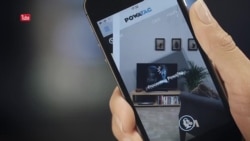Day-to-day tasks like reading a carton label or locating a dollar bill are now possible for the visually impaired.
For those with full vision, the challenges of avoiding obstacles in a self-driving car and increased security at the airport are on the verge of becoming realities.
It’s all due to image recognition, a technology that recognizes and processes data patterns online and in the physical world — everything from facial bone structure to a vacuum cleaner ad on TV.
Over the next five years, the image recognition market is expected to more than double worldwide to an estimated $30 billion, according to research firm MarketsandMarkets.
Serge Belongie, a professor of computer science at Cornell Tech, the technology-focused campus of Cornell University in New York City, says we've only scratched the surface of image recognition's potential.
“We hear a lot about self-driving cars and personal robotics, but these products are not ubiquitous yet. In fact, they are not even close,” Belongie said. “So what we’re seeing is a lot of potential, and a lot of companies like Tesla and Uber and Google investing in self-driving cars and self-driving taxis that will make extensive use of image recognition, but this has not borne fruit yet.”
When it does, he said, the market will be huge.
Privacy concerns
Apart from face detection and auto tagging — features visible to everyday social media users — Belongie said image recognition has become increasingly accessible, presenting new opportunities for advertisers to target users in ways they might not realize.
Advertisers can analyze the content of images posted to sites like Facebook, study the demographics of the people using the sites and "generate advertisements that are adaptive to the content and the images,” Belongie said.
For many users, he added, this contributes to significant privacy concerns that already exist.
“We’re posting all these pictures of family members. It could impact your ability to get a job in the future if some kind of face recognition system detects you in a compromising photo from the past,” Belongie said.
Role in counterterrorism
The technology is also taking root as a global security apparatus, such as Britain’s ThruVis scanner, which can detect concealed objects while remaining hidden among large crowds.
At New York’s John F. Kennedy International Airport, NEC Corporation of America recently unveiled its biometric facial recognition software, NeoFace, which will help identify and match facial images in a larger database and locate potential impostors who enter the country.
Allen Ganz, NEC's account development director, said the technology, now in the early stages of adoption, is improving every day to meet significant security threats.
“In the area of security or law enforcement, anywhere there are surveillance cameras presents an opportunity to utilize the technology," he said. "So the market is large, the benefits to society and public safety are great.”
However, he thinks the support of government infrastructure — via mandates and funding — can be improved to unleash the full range of security benefits from its software.
Global market share
According to MarketsandMarkets, additional growth possibilities in the image recognition market include advanced image search and shopping, increasingly from a mobile device.
North America is expected to dominate the market through 2020. However, an uptick in data analytics and cloud technologies across the Asia-Pacific region could translate to a larger market share there down the road.








